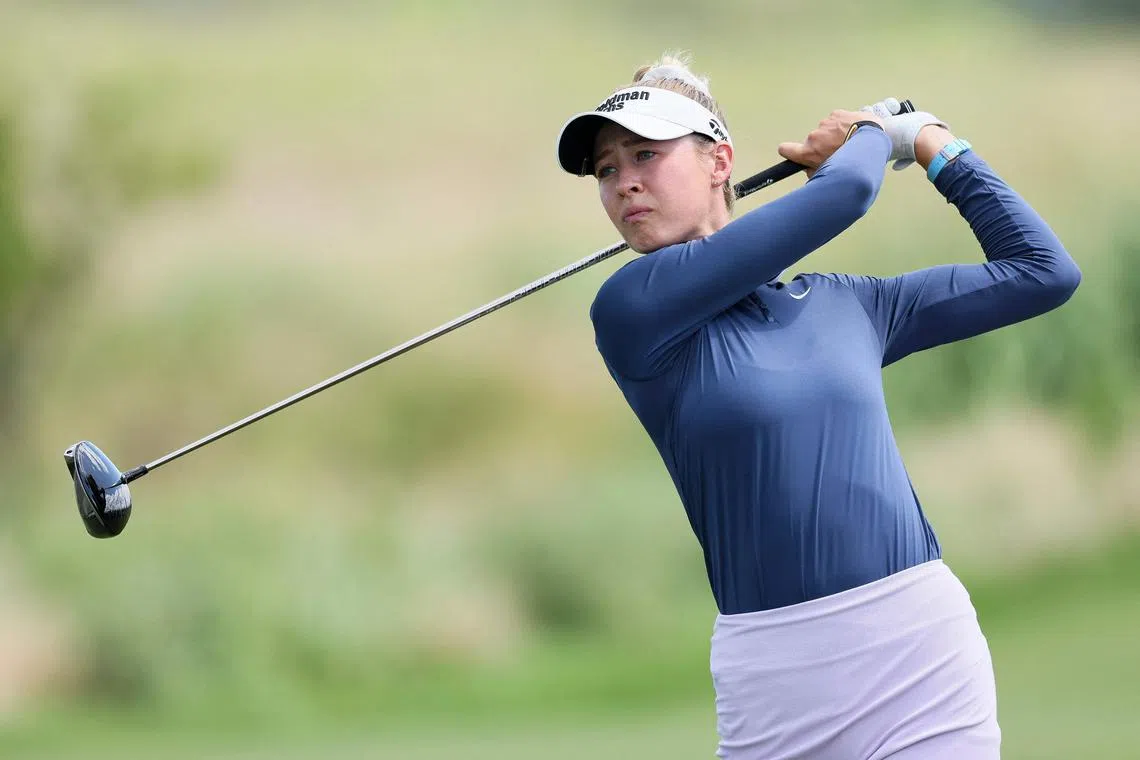The LPGA’s new boss has work to do
Sign up now: Get ST's newsletters delivered to your inbox

Nelly Korda is one of the biggest stars of women's golf.
PHOTO: AFP
Follow topic:
NEW YORK – Women’s golf has been riding a wave of increased popularity over the past five years.
At the professional level, it has a young generation of stars like Nelly Korda, Charley Hull, Minjee Lee and Rose Zhang, who are keeping fans engaged.
Korda, in winning five tournaments in a row in 2024, transcended golf to become part of the broader sports conversation for her feat.
Among amateurs, girls and young women are the fastest growing contingent of golfers. A third of junior golfers are girls – the highest percentage ever – and the number of female golfers has grown by 41 per cent since 2019, according to the National Golf Foundation.
But unlike the organisations behind women’s football or basketball, the LPGA has struggled to capitalise on interest in the sport and the star power of its players.
The league’s newly appointed commissioner, Craig Kessler, knows that leveraging interest in the women’s game to create momentum is his remit. He does not shy away from the challenges.
“We decided to hit the ground running,” he said in an interview in June.
“Urgency is at the core of what we’re going to do. At the highest level, we’re trying to create an organisation where all of our stakeholders say, ‘Something magical is happening at the LPGA, and we need to be in now’.”
The big challenge for Kessler is that the LPGA Tour depends on individual partners to sponsor each tournament, and those sponsors are only going to do so if they see value for their brands.
That comes either in attendance or television viewership. Given how far-flung the LPGA schedule is – with events on three continents each year – managing the expectations of sponsors from country to country can be a challenge.
The LPGA’s new strategy also includes building visibility, with the broadcast driving that, and getting more fans to care about the tournaments and the players.
“Right now, quite a lot of people watch the LPGA,” Kessler said. “We want people to not just watch the LPGA but to root for the LPGA. There’s a major difference there.”
The emotional investment he is looking for is akin to that which many sports fans felt watching Rory McIlroy nearly lose and ultimately win the 2025 US Masters.
“We want people to feel it in their bones,” he said.
Another challenge is the schedule. The LPGA Tour takes players all around the world, and it can be exhausting from week to week. Yet the sponsors are paying fees with the expectation that their event will be filled with the top players.
Kessler said the schedule was one of the top concerns he received from players when he walked the range at the 2025 Women’s PGA Championship.
“The question is how do we set it up so it’s great for our fan base but allows our players to rest and recover,” he said. “We’re going to make progress so we have an optimal schedule.”
Unlike their peers on the PGA Tour, many LPGA players do not earn enough to afford the perk of flying privately to far-flung events. In 2024, only 34 players made more than US$1 million (S$1.3 million).
By comparison, 137 players on the PGA Tour earned more than US$1 million in the same year.
Another concern is the quality of the coverage from event to event. KPMG introduced new technology for the Women’s PGA Championship, including analysis generated by artificial intelligence of each hole to show the optimal way to play each one.
It made for a better TV viewing experience and helped casual fans understand the challenges of the PGA Frisco Fields Ranch East course, which was hosting its first Women’s PGA Championship.
“What I didn’t fully appreciate was how different the quality of insight can be from week to week,” Kessler said. “The more we can replicate over time what the KPMG and the US Women’s Open looks like on TV, the better the product will be.”
Asked if sponsorship dollars are a factor in accomplishing this, he said, “Yes, it may be money. But I know our partners at the Golf Channel care deeply about the product.”
The former commissioner, Mollie Marcoux Samaan, who stepped down in January, had also been focused on bringing in more money, specifically increasing purse sizes.
In 2023, the purses for 32 official events totalled over US$100 million, or double the amount a decade earlier.
Yet in 2025, the LPGA cancelled the Fir Hills Seri Pak Championship, which Korda won the year before, because the sponsor had not paid any fees to the LPGA for two years.
Kessler said he thinks of the LPGA as a growth stock and that it is his remit to get the different constituents to buy into that.
“Positive energy will allow us to get people involved,” he said. “To get people involved, you can guilt them into it or inspire them.
“We’re looking to inspire them.” NYTIMES

